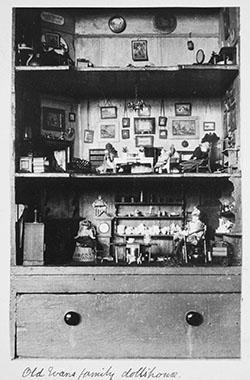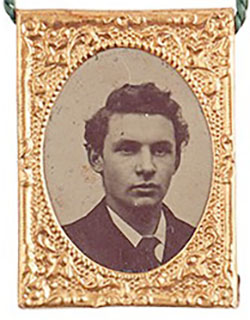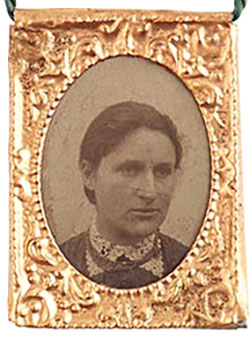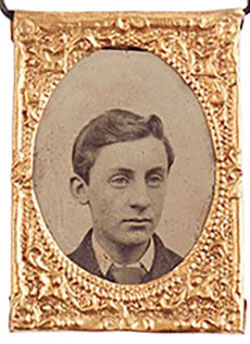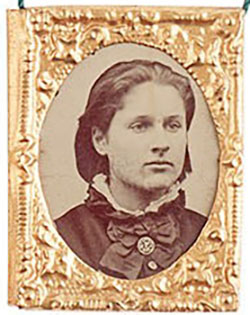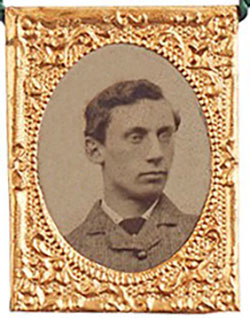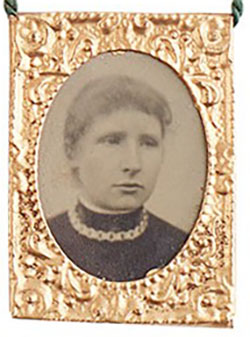The Evans Doll’s House
From an inventory by Emma Hubbard (née Evans) pages 32 - 39 of a notebook titled Furniture.
The Doll’s House
Among my old letters is one from my mother to her sister Mrs Phelps of Madeira, dated “Britwell, May 6, 1825,” which contains this passage: “Miss H. (Hancock) has sent Anne (Anne Evans 1820 - 1870) a large old-fashioned baby-house which was made for her great grandmother - it possesses little furniture but has given great delight, and Anne begged me to tell her cousins that she has this treasure, and that she hopes you will let them come and see it.”
This doll’s house stood in the nursery at Bosworth, but it was only on rare occasions when I was very young that I was allowed to play with it. Dances, dinners and other festivities went on in it; and to this day I recollect the fine appearance of the mistress of the establishment, Lady Delany, - between whom and the cook was an almost sisterly resemblance. These were only wooden jointed dolls, but of a solidity and finish to be found in no wooden dolls of this day. They never broke; their waists were of reasonably large dimensions, taking even a liberal view of what a waist should be; and their eyes, - of a pale golden green with the pupils encircled by a delicate black line, - were very effective, if not expressive - No future dolls who were domiciled with these two ever approached them in style and dignity.
I think it must have been after my father’s death (Arthur Benoni Evans 1781 - 1854) when we were going to leave Bosworth that my sister determined to restore the doll’s house to the family of the old friend who had given it to her. She therefore gave it to a Mrs. Pratt, who was I believe, a niece of Miss Hancock’s, and who had one little girl named Margie, - and the house departed, and we knew no more of it.
Many years afterwards, on Jan. 8, 1886, some of us went with Minnie Dillon, who was then nursing there, to a Christmas festivity at the Evelina Hospital in Southwark Bridge Road. - All was brightly decorated with holly and toys and trees, and there was a brightness too on the pale faces of the children - In one ward I saw a doll’s house, bedecked with holly, - which seemed to me familiar, although it was standing on legs that gave it an unaccustomed look. I went to it, and almost instinctively felt for a hole in the wood near the fastening. The hole was there, although my finger would not go into it as of old - and when I looked at the imposing front door, with the fan light over it, - and the slender pillars one on each side of the steps that rose out of mid-air to the door, I felt sure it must be the old Bosworth doll’s house.
In the course of time Agatha arrived - and then I wrote to the Matron of the Evelina Hospital to know whether I could in any way become possessor of the dear old house - She wrote to me that a cupboard was much more needed in that ward than a second doll’s house, and that if I would send them something to help towards the purchase of the cupboard, the authorities would gladly send the house - I could learn nothing from her as to when it had gone to the Hospital nor who had sent it: but on Dec. 1890 I sent a cheque for 4gns. to the Hospital and received the house. It was much out of repair; the windows were coarsely painted with a black cross to represent the pane divisions and the walls were covered with large patterned ugly papers. I put the front into the hands of a good cabinet maker, and had the woodwork of the windows put in, and I then tried to soak off the modern papers and to get back to my remembrance of the little old ugly ones of Bosworth. But the soaking was too effective - Blocks of paper came off - fold after fold of various hideous papers appeared, and I found that it had originally been painted, not papered. The papering seemed to have been a necessity, for the paint, worn and scratched in all directions, shewed cracks at the back through which daylight appeared - I mended these all as well as I could; and repainted the two upper rooms as nearly of the original colour as I could. There was a strip of coarsely stencilled red and white and black paper between the greenish bluish upper part and the white dado; and instead of attempting to reproduce that, I put strips of very old reddish Chinese paper that I happened to have.
The small sepia drawing in the lead frame is by my father, who drew it for the doll’s house - This Anne kept when she gave away the doll’s house and preserved it carefully in a little glass topped box - None of the furniture is that I remember at Bosworth; but the bedroom sets in light wood and some other things were given to my children by the Copes, in whose Doll’s house at Osbaston (near Bosworth) they used to be - The kitchen is untouched in the paint both of the walls and floors - and the grate which fits so well was given me by my old maid Agnes Windeatt. In the drawing room the little model brass grate was given to the house in 1896 by George. (George Hubbard 1859 - 1936)
On taking off the papering of the two upper rooms (the kitchen is as I always remember it), I came across small, tinted engravings, 6 in the drawing room and one in the bedroom which had evidently been part of the original decoration of the house. The only one with a title was the bedroom picture, in which a man bearing a stick over his shoulder, advances towards an odd circular roofed edifice, with a lean-to attached - This had its name on the side of the circular margin, and was called “Lonely.”
The old Evans Dolls’ House as it probably looked like in the late 1890’s early 1900’s
Update January 2022
Mary Elizabeth Stuart HARLEY (1926 - 2019) was a descendant of Harriet Ann EVANS 1857 - 1938 and Charles James LONGMAN 1852 - 1934.
The Covid pandemic held up the sale and contents of her house until 2022. She still owned the Evans’ Doll’s House. It had been in the family since around 1825.
The executors of the estate have come to the decision to sell the house by auction on the open market
Update Late February 2022
The Dolls House was sold for £47,500, less fees and commissions.
Dolls’ House Pictures
Some of the pictures in the Dolls’ House
Details in Emma EVANS handwriting are on the back of the pictures, except for one.
Left to Right
A pastoral scene drawn by Arthur Benoni EVANS 1781 - 1854 for the dolls’ house
when it was first given to Anne EVANS 1820 - 1870, his daughter
George HUBBARD 1859 - 1936
M. MAY(?)
Frank EVANS (Francis Bennett-Goldney, born EVANS) 1862 - 1918
M.MAY (?)
Unidentified
'Dick’ Frances HUBBARD 1862 - 1919
